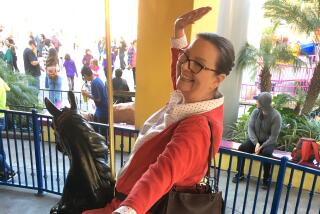Beginning of a Better Ending
- Share via
Before a medical-school course paired her with a 28-year-old woman dying of cancer, Amy Hansen had no idea that terminally ill patients fear their doctors and nurses will abandon them if they reject medical heroics.
As the two women talked throughout that semester, the patient was the teacher--perhaps one of the most influential in Hansen’s training.
Hansen learned that although doctors drive decision-making through many stages of illness, patients want control as death approaches. She learned that it’s important to care, not just cure. She came to see that chemotherapy and radiation could be administered simply to keep a tumor in check--not eradicate it--during the patient’s final months, without the side effects that diminish quality of life.
“Addressing her fears was one thing I appreciated from the course,” said Hansen, today a fourth-year Harvard medical student headed toward a neurology residency at UCLA.
Hansen takes these lessons with her every time she talks to seriously ill patients who need to feel safe before revealing their true wishes about their care.
“I think people may be scared to question the do-everything-possible approach,” Hansen says. “They need a lot of reassurance.”
Providing doctors with firsthand exposure to the dying is the goal of a growing movement in American medicine. The Harvard course, along with similar programs elsewhere, seeks to teach what textbooks and traditional medical education haven’t: what to do when your lifesaving skills are no longer needed, but your patient still needs you.
A recent study in the Journal of the American Medical Assn. found that medical textbooks offer woefully scant information about caring for patients in their final days.
In evaluating 50 top-selling textbooks in 12 specialties, “it was incredibly rare for chapters to deal with issues around the family, psychological issues for the patient, ethical issues of medical decision-making, and spiritual issues,” said lead study author Dr. Michael Rabow, an internist at UC San Francisco.
The specialty texts that did best were in family and primary-care medicine, psychiatry and geriatrics. Those in surgery, cardiology, AIDS and pulmonology--where death is a frequent outcome--did the worst.
The study also found insufficient attention to pain control, underscoring patients’ fears that they’ll suffer unnecessarily.
For Rabow, textbooks highlight how medicine treats “death as the ultimate enemy, to be fought against and beaten essentially at any cost--a model that doesn’t put death as a natural part of the human life cycle.”
That model is changing as society acknowledges that physicians have a responsibility to see patients through the entire course of illness and help them face death.
Dr. Linda Emanuel, American Medical Assn. vice president for ethics, sees the end of an era in which physicians “would feel unabashed in saying that we were saving lives and stamping out disease and [that] death was just not an option we needed to consider.”
And with the AIDS epidemic’s deadly toll and baby boomers’ growing responsibilities for aging parents, people have increasingly reported unhappiness with the way loved ones have died.
Meanwhile, support for hospice and palliative-care programs has grown, as debates about physician-assisted suicide have drawn attention to deficiencies in care for the dying.
Dr. Susan Block, chief of psychosocial oncology at the Dana-Farber Cancer Institute in Boston, has watched attitudes toward end-of-life caregiving evolve since she was a hospice medical director in the early 1980s.
“People thought that being interested in the care of dying patients was like being a pervert, that you were strange to be interested in death and dying.”
Fortunately, she said, “the stigma has diminished.”
Medical schools across the country are instituting programs to educate medical students, interns, residents and even midcareer doctors about dealing with dying patients and their families--work that typically has fallen to nurses, the clergy and social workers.
At UCLA, Dr. Neil Wenger, an internist who chairs the ethics committee, says medical institutions must stop assuming that just because a doctor deals with dying patients, that doctor has end-of-life expertise.
“There are specific techniques, specific ways of helping a patient and family deal with grief, of enhancing the spirituality of the situation. . . . These are all special techniques one has to learn. They’re not inherent and they’re not obvious.”
Dr. Michael S. Wilkes, who oversees UCLA’s “doctoring curriculum,” uses a team approach to teach about doctor-patient relationships, ethics and communication skills. To help students grasp the role of spirituality in dying, they shadow pastors on bedside rounds, learning what death means in Judaism, Buddhism, Catholicism, Hinduism.
In the last nine months, Wilkes has shared his curriculum-development expertise with 17 medical schools as they undertake a “whole re-educating of the profession.”
The American Medical Assn. created Education for Physicians in End-of-Life Care, a train-the-trainer program that aims “to touch every single practicing physician by the time we’re done,” said the AMA’s Emanuel.
Making Doctors Comfortable Too
An internist at Northwestern Memorial Hospital in Chicago, Emanuel has not only heard tales of doctors’ discomfort with death, she’s observed it.
“I have a vivid memory of a colleague whose words to a lung-cancer patient we saw on rounds went something like the following: She said, ‘What would you do if you were I?’ And he said, ‘Well, Mrs. X, I’m not you. I don’t know what I would do.’ And he left the room a little too hastily. It stuck in my mind as paradigmatic.”
Emanuel said patients fear receiving less care once a doctor has exhausted the medical arsenal.
“Many patients and many physicians and many families have experienced the declining visits, the lowest-level-of-care bed,” Emanuel said. “I don’t think the data is there, but it’s a very widely held perception.”
One of the forces trying to change that is the Robert Wood Johnson Foundation, which focuses on health care and has poured millions of dollars into end-of-life care programs and studies.
The foundation-supported AMA program for end-of-life care has trained 500 doctors, each of whom is committed to spreading the word. About a third of the doctors have rolled out large programs of their own.
The National Cancer Institute has also gotten involved, helping fund a Harvard program that targets midcareer doctors with teaching responsibilities, hoping they will share the lessons in palliative care.
“Even senior physicians who have had many years of experience and hundreds if not thousands of dying patients have had zero teaching about bereavement, which is shocking because family members often feel very connected to these physicians,” said Block, who runs the program.
Dr. Thomas Lynch, medical director of the Massachusetts General Hospital Thoracic Oncology Center, took Block’s course 10 years into his career.
Although the majority of his patients with lung cancer die, “the issue of bereavement care and the bereavement process from the standpoint of the professional caregiver had never been addressed in any forum when I was a medical student, a resident, a fellow and a senior attending physician.”
Block is particularly concerned about getting through to medical students. She says schools are missing valuable opportunities to expose future doctors to the experiences of dying patients, exposure she feels can be enriching even while emotionally draining.
“I feel if I’ve been able to be helpful to the patient or family, that diminishes my sense of grief and distress about the loss,” Block said. “I think that part of what’s so toxic about it is that feeling of helplessness that many doctors feel when someone is dying. We think there’s really an opportunity to make a difference here, where other people have pulled away.”
Block and a colleague at the University of Pittsburgh recently analyzed 150 patient deaths in the hospital and found only two cases where medical students were involved.
“That means one way or another, medical students are being protected--or deprived of an opportunity to learn about death and dying,” she said. The medical residents who supervised them either felt the students had too little expertise to be present or felt that because the patient was dying there’s not much the student can learn.”
That’s why she sees such value in bringing medical students together with terminally ill patients.
Just as doctors feel like failures if they can’t cure, dying patients too may feel they’ve failed if they don’t put up the constant fight.
But programs like the Harvard elective help them feel they’re contributing to improved care for future generations. They’re able to show medical students that compassion and communication can make them better healers, and that patients have a right to choose how they die.
Block recounted a memorable hospital encounter in which she asked a 40-something schoolteacher in the end stages of cancer to share some of her precious remaining time with a medical student.
“She was very eager to do it and clearly was doing it with sort of a legacy idea,” Block recalled. “I was leaving the room and her husband came in and she looked at him with tears in her eyes and said, ‘Honey, I have one last teaching gig,’ ” Block recalled. “We were all in tears.”






